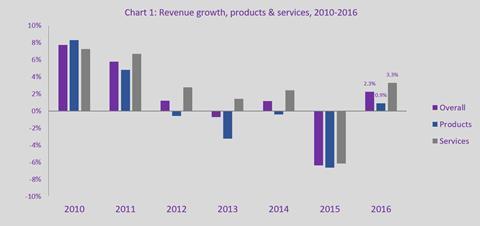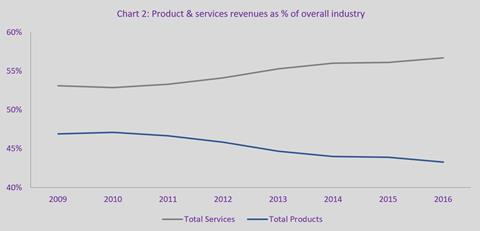The latest IABM DC valuation of the technology supply market points to growth in both services and product revenues.

IABM DC, a joint venture between IABM and Devoncroft, produces an annual market sizing report on the broadcast and media technology industry, the Global Market Valuation and Strategy Report (GMVR).
The GMVR provides users with the definitive valuation of the broadcast and media technology supply market, with detailed market sizing information on products and services sold into professional media contexts.
Sizing of current year and previous year markets is provided on a three-region basis (NALA /EMEA / APAC) for over 150 product categories and 10 service categories. High-level forecasting is provided for eight product segments (together containing the 150 product categories) and 1 services segment.
In addition to a full set of data tables across the whole industry as described above there is a 700 page report that delves deeper into all segments, sub-segments and product categories.
IABM’s status as the main trade association for suppliers of professional media technology, and the collaboration of its member-partners, provide the report with a unique level of detail and data accuracy.
The latest figures from the GMVR showed an improvement in the overall performance of the broadcast and media technology industry in 2016. In fact, the overall industry grew revenues by 2.3% in 2016 (estimate) compared to -6.3% in 2015.
It is important to point out the difference in revenue growth between products and services in 2016: services grew by 3.3% while product revenues increased only by 0.9%. The chart below shows the growth in product, service and overall industry revenues in the period 2010-2016.

The time-series shows that product revenues were growing at a high rate in 2010 – higher than service revenues – but then progressively decreased from 2011 onwards. Service revenue growth overtook product revenue growth in 2011 and remained positive in the whole period except from 2015 (the gloomiest year for suppliers’ revenues).
This shows that, after 2011, end-users’ spending priorities have shifted from HD and digital channel deployments to a more radical change in their technology infrastructures. This structural shift in spending became evident in 2015 with the supply industry going through its direst year since the GMVR project started.
As often highlighted by IABM DC, this transition is not just an upgrade of the traditional technology infrastructures but a cultural change in the supply-side model. The priorities for end-users are now streamlining their technology infrastructures through IP and cloud technology and making sense of the enormous amount of data harvested through online delivery of video.
From a supply-side perspective, the change in end-users’ preferences marked a shift from traditional selling practices to a next-generation model.
This transition is still ongoing; some media technology suppliers have already embarked on a sometimes painful transition to a service model. More than ever, these services are offered in a virtualised environment where customers can pay-as-they-go and avoid the sunk costs of the past.
This can be considered as a “cultural” revolution for traditional media technology suppliers as well. Going from selling hardware to selling software as a service (SaaS) is indeed not easy to implement. It requires the underlying transition from a Capex financing model to an Opex financing model – from large upfront payments to smaller, more regular cashflows.
The move to service revenues over the last six years is evident when looking at the GMVR data: this shows that the service revenue percentage was 57% in 2016, up from 53% in 2009.

The segment and sub-segment level data gives a more detailed picture of what is growing and what is declining in the industry.
While the GMVR is widely acknowledged as the most comprehensive source of data in the broadcast and media technology space, not all companies require its industry-wide breadth of information. Recognising this, IABM DC has recently introduced GMVR Essentials to enable every broadcast and media technology company to access critical information for their business planning at an accessible price.
GMVR Essentials are category-specific reports and data tables abstracted from the GMVR. GMVR Essentials reports include essential market data, sizing and forecasting for specific categories of product as well as a strategic overview of industry trends, regional dynamics, and emerging technologies – offering laser-focused, authoritative and comprehensive data and market trends. The 22 categories offered are shown in the image below.

GMVR Essentials reports also include a comprehensive strategic industry overview covering the entire broadcast and media technology sector – consisting of some 120 pages with a summary of the nine segments. This gives an authoritative picture of key facts and trends across the whole broadcast and media industry, providing essential context for business planning.

GMVR Essentials reports are offered at an accessible price point to give smaller companies the opportunity to access just the information that is relevant to their current business areas and/or ones that they are considering moving into. As well as focusing business planning, GMVR Essentials reports also provide a credible, authoritative background for companies’ 2018 budgets – invaluable for board approval and investor confidence.
In a period of unprecedented change for the media industry, accurate market information has never been so important. By introducing GMVR Essentials, IABM is making this available to every broadcast and media technology company.
For more information regarding the GMVR Essentials reports please visit here.
Lorenzo Zanni is IABM Research Analyst.
























No comments yet